12DOVE Verdict
Pros
- +
New Marais is vibrant and fun to explore
- +
Combat's more fun
- +
with cooler abilities
- +
Enemies are more diverse
- +
less frustrating
Cons
- -
Upgrade system demands consistent moral choices
- -
Still no fast travel system
- -
Endgame steals a little too blatantly from comics
Why you can trust 12DOVE
In spite of the way fans embraced the first InFamous back in 2009, it had a few glaring flaws that kept some critics (myself included) from fully recommending it. As fun as the morally ambiguous superhero-sandbox game could be, it suffered from too-sticky platforming, a limited repertoire of powers, repetitive city design and exploration that was hampered by near-constant gunfire from ever-present death squads. Underneath those problems were the beginnings of something great, however, and with InFamous 2, that promise is finally realized.
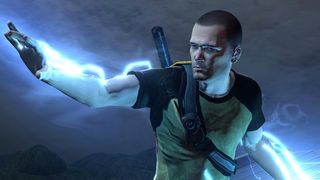
Where the first game’s Empire City was a bleak sprawl of same-y rooftops, plazas and alleyways, InFamous 2 moves the action to New Marais, a stand-in for one of America’s most unique cities, New Orleans. You’ll still be magnetically drawn toward the nearest platform or ledge while jumping around, but it’s been fine-tuned to the point where you’ll no longer be sucked onto a nearby lamppost every time you try to jump away from a grenade.
Enemies pop up frequently, but not constantly, and the powers you can use to dispatch them are much more diverse and interesting than they were in the first game. Even the close-quarters combat’s gotten better, provided you have a high tolerance for its 300-style, slow-fast-slow presentation. In short, there’ve been a lot of improvements, and most of the irritations from the first game are gone. So how does InFamous 2 stack up on its own?
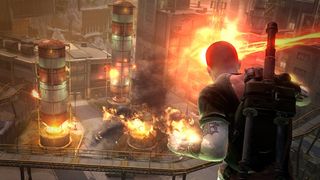
Picking up a few months after InFamous left off, the sequel once again follows morally challenged superhero/villain Cole MacGrath, who flees to New Marais after The Beast (a monstrous, superhuman force of nature foretold in the first game’s ending) appears and reduces Empire City to a cinder. If he’s going to take on The Beast – an ever-approaching threat whose distance from New Marais pops up onscreen periodically – Cole will have to become more powerful, something he can only do by collecting battery-like “Blast Cores” hidden around the city.
Of course, The Beast isn’t Cole’s only problem. In the chaos following Empire City’s destruction, a redneck militia – simply called The Militia – has taken control and vowed to stamp out superhuman “deviants” like Cole. Also of concern are rampaging swamp monsters and a small army of mercenaries with ice powers, who add a bit of diversity to the opposing forces and ensure that you’ll have to deal with more than just being shot at all the time. They’re also an excuse to throw in some monstrous bosses, at least one of which is a towering beast that looks like something out of Lost Planet, complete with glowing weak points.
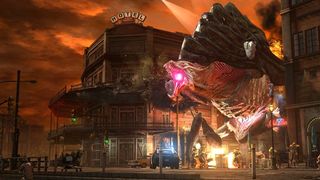
Like its predecessor, InFamous 2 is set in a sprawling open world, which you’ll get around mainly by climbing buildings and grinding on power lines (there’s no fast-travel feature, though, which can make getting from one end of the city to another kind of a chore). As a human Tesla coil, Cole’s ammunition and health are replenished by electricity, and the city’s filled with convenient power sources for him to drain when things get dire. Also, like in the first InFamous, parts of the city need to be “powered up” before you can safely operate in them. The difference is that now, instead of activating electrical transformers in repetitive sewer levels, Cole charges up several above-ground ones using remote-controlled “Tesla Missiles” (which can also fry enemies mid-flight).
As a game world, New Marais is a lot more interesting than the crumbling Empire City; for starters, it features a lot of diverse areas, ranging from neon-drenched urban centers to miles of swampland and a completely flooded suburb (this is a city patterned after New Orleans, after all). There’s also plenty of stuff to do and see, even when you’re not paying attention to the story missions. Like in the first game, there are side missions to pursue (which help you reduce Militia influence in chunks of the city) and energy-boosting Blast Shards to ferret out, but there’s incidental, karma-affecting stuff as well, like street musicians you can terrorize, or muggers you can stomp mid-holdup. (You’re free to ignore this stuff, of course, but it does help keep New Marais from ever feeling empty or boring.)
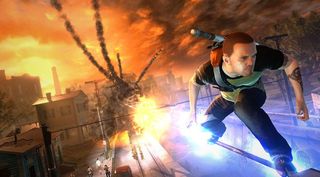
Lucky for Cole, he’s not going it alone this time. In addition to his annoying buddy Zeke (who actually manages to become likable and sympathetic this time around), Cole gets some help from two women: Kuo, a by-the-book NSA agent who starts the game as Cole’s handler, but eventually gets superhuman abilities of her own; and Nix, a swamp-dwelling sociopath with flammable, oil-based powers.
As you can probably guess, Kuo and Nix are a big part of the game’s morality system, and each major decision tends to come down to which one you want to side with. Nix favors plans that are destructive, devious and guaranteed to get people killed, while Kuo pushes Cole to do the “right” (and frequently boring) thing. Should you earn the trust of anti-Militia rebels by letting Nix put on a Militia disguise and attack them (thus enabling you to swoop in and save the day), or by helping Kuo drive an ambulance loaded with medical supplies to them? Should you help Nix take control of an army of monsters, or help Kuo expose the people who already control them?
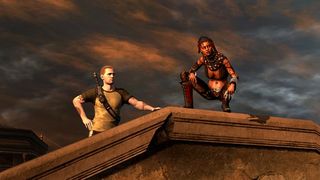
Your choices register on Cole’s karma meter, and they affect not only which missions you’re offered, but also Cole’s appearance, which powers become available to him and, ultimately, the ending of the game. (You’ll still be offered a decision, but one of the choices will be locked unless you want to go off and help/hurt enough people to push your karma into good or evil status.)
You’re free to dart back and forth between good and evil decisions, but it’s in your best interest to be consistent. New powers take some doing to acquire, as you’ll now have to A) make it to a point in the story where they become available; B) perform a set task to unlock them (i.e. getting six headshots, or destroying four cars in as many seconds); and C) spend experience points to buy them. And because some of those powers are locked to good or evil karma, going back and forth will effectively bar you from using some of them.
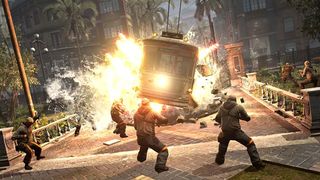
As for the powers themselves, Cole has the same standard, gun-stand-in attacks that he did in the first game (most of which get stripped from him at the start), including pistol-like lightning shots, energy grenades, force-wave “blasts” and lightning rockets. This time, however, there are a lot of variants, which you can quickly switch between using a d-pad menu. Rockets can split into bolo-like pairs, connected by a string of lightning. Grenades can be powered up to stick to enemies or bounce into the air before exploding. And Cole’s basic lightning can be augmented in a number of different ways, from adding rapid-fire to focusing the blasts into slower, magnum-sized bolts.
Melee abilities can be beefed up as well, with quicker combos and showy finishers built around Cole’s new, two-pronged Amp weapon, and some of the new powers can even help Cole get around quickly, such as the grappling-hook-like Lightning Tether (which is a lot of fun to use, but sadly doesn’t show up until near the end of the game). Probably the best addition, however, is the ability to telekinetically pick up objects – up to and including cars – and hurl them at enemies, into the sides of buildings or simply far into the distance. (Strangely, this doesn’t seem to affect your karma at all, even if you explode the car with a driver inside.)

Above: You'll alsounlock a few devastating"Ionic" super attacks, which are great for when you're grossly outmatched
Interestingly, there’s plenty of content to play around with even after you’ve finished the story, provided you have a high tolerance for user-created missions. After hitting a certain point in the story, players get the ability to create their own content with a surprisingly simple to use (but complicated at first to learn) system that combines freeform logic switches with a rubber-stamping tool. Missions can be set anywhere on the game map (by simply going there before you switch over into User-Generated Content mode), and every monster, object and person in the game is at your disposal to edit however you like. It’s even possible to add rudimentary, voiceless cutscenes, if you really want to get a story across.
More info
| Description | A huge improvement over its predecessor, InFamous 2 injects more variety, personality and fun into the first game's promising formula, while removing or fine-tuning its most irritating flaws. |
| Platform | "PS3" |
| US censor rating | "Teen" |
| UK censor rating | "16+" |
| Release date | 1 January 1970 (US), 1 January 1970 (UK) |

Nintendo Switch 2 launch price won't "really matter," analyst says, because early Nintendo buyers "aren't very price-sensitive" anyway – if it's not "egregious," it will sell

Nintendo Switch 2 leaks "essentially ruined the reveal" according to one analyst: "It was very unfortunate for Nintendo"

The Hollow Knight: Silksong ARG turned out to be us clutching at straws, but dev says: "the game is real, progressing and will release"
Most Popular

